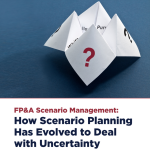This paper evaluates the transition process, and the challenges organisations may encounter when embracing the Scenario...

Scenario Management helps us create different plausible future scenarios to enhance decision-making processes. Unlike traditional forecasting methods that predict a single future outcome, Scenario Management recognises the uncertainty inherent in today's global environment. It encourages organisations to consider multiple possible futures, each with its unique set of challenges and opportunities.
It is easy to understand why this method has become so relevant in today’s rapidly changing and unpredictable world. The range of plausible futures is bigger than it has ever been. Moreover, uncertainty compounds rapidly: the 10 possible scenarios of tomorrow will be 100 the day after, 1000 one day later and so on. That is not very similar to the usual planning done 5 or 10 years ago.
The fact that planning has become more difficult does not mean it is unnecessary. On the contrary, the more complex it is, the more you feel the need to plan, the more “wrong” your plans will be, so the more you will need a new plan, over and over again. One way to address this concern is to ask yourself: “Why and what am I planning?”
Basically, you can classify your planning efforts into three main categories:
- Strategic Planning
- Financial Planning
- Operational Planning
However, their boundaries are blurred, and they are very much interrelated. Still, they are best when done in conjunction, resting on a consistent hypothesis. Let us look at each in detail.
Strategic Planning
This is a long-term exercise covering the broadest range of plausible futures. The uncertainty is highest with several interdependent assumptions. Planning the smallest details is not needed, but you have to identify key drivers of change and future trends. Strategic Planning is a boardroom responsibility, as it can be too abstract for line management. It may be valid for a few years afterwards if done appropriately. Scenario Management will not predict which scenario will materialise, but it helps anticipate potential challenges and implement proactive strategies by exploring various future possibilities.
Relevant scenarios for this sort of planning may include technological breakthroughs and policy regulations capable of changing the course of entire industries in a lasting way. Such events may happen within a longer timeframe, but they will be here to stay.
Think of power generation technologies and policies as an example. Nuclear power generation regulations, technological progress applied to sources of renewable energy enhancing the economic viability of several countries, and liberalisation of the energy markets are just three related aspects of the revolution for suppliers, operators and customers alike within the industry. As a matter of fact, each of these three aspects would have been worth Scenario Planning well before they happened, based on public opinion, environmental concerns and a general trend towards liberalisation policies.
Financial Planning
Here, the time horizon is shorter but may still be longer than a year. The planning cycle is also shorter as you will need to go through this exercise each year and check on progress regularly. Uncertainty is lower than in Strategic Planning but still high. In this case, you will need precise plans and complete financial statements. You will want to look into the coming few months or even weeks in depth, e.g., for anticipating cash flows. Ownership will probably reside with the finance function: they are best placed to define the goals of your yearly planning exercise based on your industry and the needs of your company. Moreover, they can arrange the systems to support the whole process. Scenario Management will not help you as a forecasting tool; rather, it would be an instrument to anticipate trends, customer preferences, or technological advancements and evaluate their impact on your financials.
Examples of possible scenarios include product launches or changes in competitors’ and customers’ landscapes. Suppose your plan is strongly dependent upon new product launches. In that case, you need to test the assumptions very carefully and develop scenarios for managing the associated risks:
- What portion of your turnover is achieved through new products that you have not launched yet?
- Have you assigned enough financial resources for their launch?
- How high is your break-even point?
- What happens if they flop?
In this case, an accurate estimate of a product’s profitability is fundamental to assessing the scenario’s entirety. Note that such a process will require separating direct and incremental costs from overheads that you will have regardless of the success of your products. Similarly, you will want to consider scenarios involving your customers if you are over-dependent on some of them. That means you will want to monitor large customers with dubious creditworthiness, adopt early warning systems and manage them. For instance, you can consider accepting only smaller orders and only after the payments for the previous ones, or even only subject to prepayments.
Operational Planning
With operational planning, you look at the very short term. The range of plausible futures is more limited, but they are often binary: either they happen or do not, and the result for both cases is quite certain. When they happen, they do it fast. Here, the skills of line management are required, as they are closest to the action. You will probably not have to plan too many things, but those few things will have to be planned precisely.
Typical applications of Scenario Management in operational planning could be trading activities and capacity planning. Should you plan additional capacity to accommodate a customer-specific consumer campaign that your clients will probably only confirm at the last minute? What are your lead times in order to make a decision? Is the rest of the organisation aware of this? Do you have an alternative action already defined in times of crisis? The answers to some of these questions can be very industry-specific, so you will already have taken countermeasures into account, such as defining the right balance of tailor-made and standard promotions and products. You will also anticipate presentations to customers in order to enable earlier decisions and so on. Even though such scenarios are easy to quantify, it is important to elaborate the action plan long before the event.
Conclusions and Recommendations
To summarise, here are three takeaways that may help you implement Scenario Management within your organisation:
Plan for the unplannable
Do not use Scenario Management for sensitivity analysis. The latter shows you the sensitivity of a model to changes in a specific input variable, while Scenario Management allows you to change the value of several variables simultaneously or even the variables themselves. This is only applicable to managing unforeseeable or even improbable circumstances.
Identify the key drivers and monitor them continuously
For example, if your scenarios are based on certain macroeconomic indicators, establish regular reporting, tolerance corridors and early warning indicators.
Exercise on the various scenarios
Assign them new probabilities, and ensure the options you have identified as responses are still right. Alternatively, adjust them to the actual circumstances or even identify new ones.
The difference between Scenario Management and forecasting should be clear now. The better you are at defining and managing scenarios by understanding their implications for your organisation and your financials, the more prepared you will be and the less forecasting you will need. At the end of the day, you will be ready for whatever happens.
Subscribe to
FP&A Trends Digest

We will regularly update you on the latest trends and developments in FP&A. Take the opportunity to have articles written by finance thought leaders delivered directly to your inbox; watch compelling webinars; connect with like-minded professionals; and become a part of our global community.






